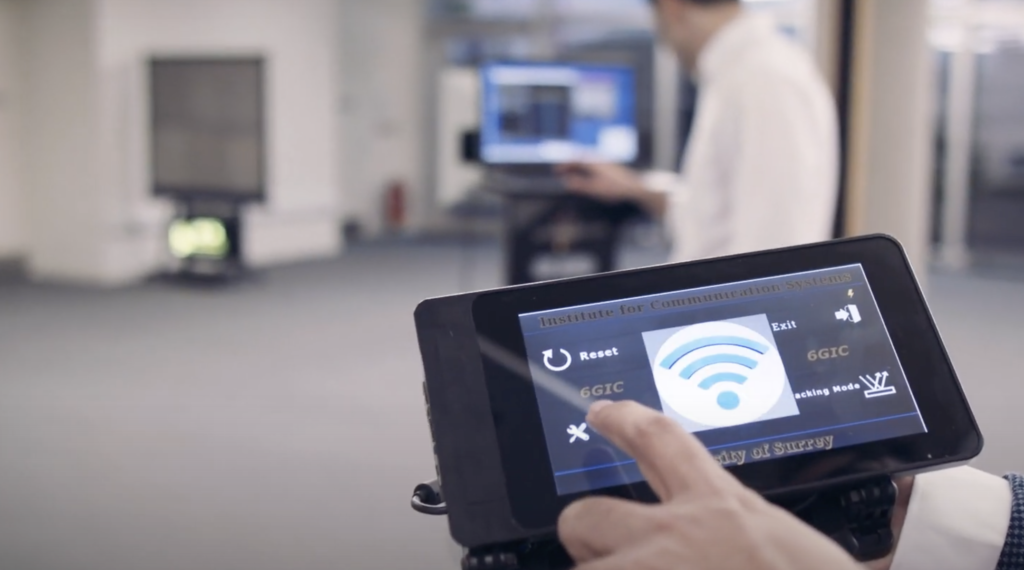I have written several blog posts about how the hardware concepts of reconfigurable reflectarrays and metasurfaces are gaining interest in the wireless communication community, for example, to create a new type of full-duplex transparent relays. The technology is also known as reconfigurable intelligent surfaces and intelligent reflecting surfaces.
In my latest magazine paper, I identified real-time reconfigurability as the key technical research challenge: we need fast algorithms for over-the-air channel estimation that can handle large surfaces and complex propagation environments. In other words, we need hardware that can be reconfigured and algorithms to find the right configuration.
The literature contains several theoretical algorithms but it is a very different thing to demonstrate real-time reconfigurability in lab experiments. I was therefore impressed when finding the following video from the team of Dr. Mohsen Khalily at the University of Surrey:
The video shows how a metasurface is used to reflect a signal from a transmitter to a receiver. In the second half of the video, they move the receiver out of the reflected beam from the metasurface and then press a button to reconfigure the surface to change the direction of the beam.
I asked Dr. Khalily to tell me more about the setup:
“The metasurface consists of several conductive printed patches (scatterers), and the size of each scatterer is a small proportion of the wavelength of the operating frequency. The macroscopic effect of these scatterers defines a specific surface impedance and by controlling this surface impedance, the reflected wave from the metasurface sheet can be manipulated. Each individual scatterer or a cluster of them can be tuned in such a way that the whole surface can reconstruct radio waves with desired characteristics without emitting any additional waves.”
The surface shown in the video contains 2490 patches that are printed on a copper ground plane. The patches are made of a new micro-dispersed ceramic PTFE composite and designed to support a wide range of phase variations along with a low reflection loss for signals in the 3.5 GHz band. The design of the surface was the main challenge according to Dr. Khalily:
“Fabrication was very difficult due to the size of the surface, so we had to divide the surface into six tiles then attach them together. Our surface material has a higher dielectric constant than the traditional PTFE copper-clad laminates to meet the design and manufacturing of circuit miniaturization. This material also possesses high thermal conductivity, which gives an added advantage for heat dissipation of the apparatus.”

The transmitter and receiver were in the far-field of the metasurface in the considered experimental setup. Since there is an unobstructed line-of-sight path, it was sufficient to estimate the angular difference between the receiver and the main reflection angle, and then adjust the surface impedance to compensate for the difference. When this was properly done, the metasurface improved the signal-to-noise ratio (SNR) by almost 15 dB. I cannot judge how close this number is to the theoretical maximum. In the considered in-room setup with highly directional horn antennas at the transmitter and receiver, it might be enough that the reflected beam points in roughly the right direction to achieve a great SNR gain. I’m looking forward to learning more about this experiment when there is a technical paper that describes it.
This is not the first experiment of this kind, but I think it constitutes the state-of-the-art when it comes to bringing the concept of reconfigurable intelligent surfaces from theory to practice.

The first time I heard about reconfigurable surfaces was about a year ago when I talked to a fellow grad student in our lab at UBC. I mocked the idea at the time as it seemed utterly impractical to me. To this day, I have been stubborn enough not to read a single paper on reconfigurable metasurfaces.
As Neil deGrasse Tyson pointed out in his master class, “It is equally intellectually lazy for you to say that an idea will not work without asking questions as accepting any stupid ideas.”
I am thrilled to see this video, and I congratulate Dr. Khalily and his colleagues.
Hi,
Thanks for the nice post.
I am wondering how the receiver estimates the channels of 2400 elements?
I did not find any information regarding the channel estimation in the video.
Many thanks.
This is a good question and I don’t know the exact answer, but I’ve got the impression that they are not estimating the individual channels to the 2400 elements but instead the angle of arrival from the transmitted and the desired angle of departure. From this information, you can compute the desired phase shifts of all the element. A parametrization like this would work well in a setup with only one dominant path and far-field propagation. See my recent paper on “two critical questions” where we discuss different estimation algorithms.
Many thanks Prof. Bjornson for clarifying this.
Dear Prof. Bjornson,
I understand that Reconfigurable Intelligent Surfaces (RISs) are still in the early stages of development and are not yet standardized or widely commercialized, but I was wondering if you might be able to provide me with any information on how someone can create a RIS prototype, such as any related papers or manufacturers that you know of?
Thank you for your time and consideration.
One of the first testbeds was designed at the University of Surrey. It is described in the paper “Reconfigurable Intelligent Surface (RIS) in the Sub-6 GHz Band: Design, Implementation, and Real-World Demonstration” (https://ieeexplore.ieee.org/stamp/stamp.jsp?arnumber=9668918)